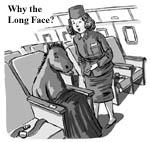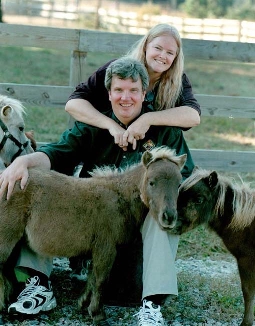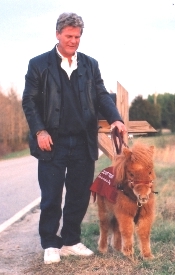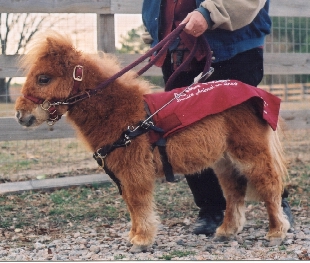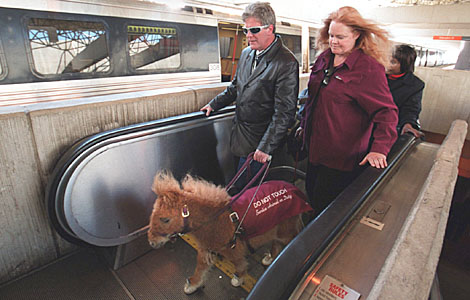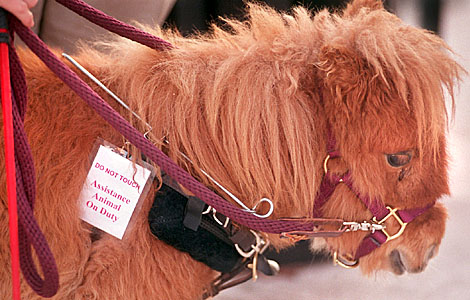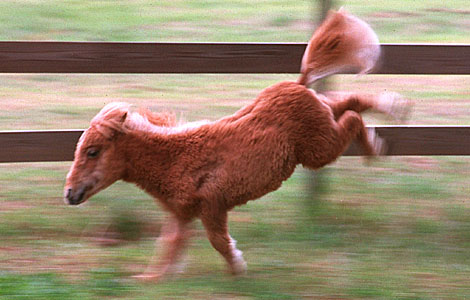|
The Guide Horse
Foundation A non-profit charity dedicated to providing free guides for visually impaired individuals. |
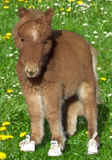 |
|
Frequently Asked Miniature Horse Questions This is a list of the most frequently asked questions about Miniature horse Guide Horses. If your question is not on this list, please feel free to e-mail us with your question. How long do Horses live? Horses commonly live to be 25 - 35 years old, and on-average, miniature horses may live one-third longer than large horses. This size-longevity relationship is the same for dog breeds. For example, a Rottweiler may live to be 12, while a Chihuahua may live to be 18 years old. Janet Burleson owns two miniature horses who were born in 1971 who are still very healthy. Angel, a dwarf miniature horse who lived with the Horse Protection Society of North Carolina, was among the oldest living mini horses, at an age of over 50 years-old. . Angel, a dwarf horse in her 50's. How small is the smallest horse? According to Del Tera Miniature Horse Farm of Inman South Carolina , the smallest miniature horse in recorded history was a stallion named "Little Pumpkin." He stood 14 inches tall and weighed only 20 lbs. However, the Guinness Book of World Records lists Black Beauty as the worlds smallest miniature horse at 18.5 inches tall.
How small was the smallest miniature horse breeding stallion? According to the American Miniature Horse Association (AMHA), the smallest miniature horse breeding stallion in America was Bond Tiny Tim. In the AMHA Online stud book, Bond Tiny Tim is listed as a miniature horse stallion measuring only 19 inches tall. Bond Tiny Tim was a dwarf horse who was bred extensively and appears in the pedigrees of hundreds of miniature horses in America. Bond Tiny Tim sired numerous national champions and lent his dwarf genes to generations of his descendents.
Do Guide Horses live indoors? All Guide Horses regularly work indoors, leading their handler to restaurants, shopping malls and offices. When they are off-duty, Guide Horses greatly prefer to stay outdoors. All Guide Horses have a small outdoor barn and corral to relax , graze and play. In the summer, they get a thin coat that allows them to be comfortable in hot and humid areas. In the winder, they get a wooly coat that keeps them warm, even in sub-zero temperatures.
What is the criteria for a miniature horse to be chosen for service as a Guide Horse? Prior to acceptance into the Guide Horse training program, all miniature horses are required to pass a thorough physical examination by a licensed Equine Veterinarian. Size is also an issue, and all miniature horses must measure less than 26 inches high at the withers to enable accessibility for their blind owner. The miniature horse must also possess structurally sound legs, good health and demonstrable stamina. Only those miniature horses certified sound and healthy by the Veterinarian are accepted into the program. All Guide Horses are also tested for intelligence prior to entry into the training program. During training, the miniature horses undergo periodic physicals to ensure their continual health and soundness. The GHF only accepts mini horses that are capable of meeting the rigorous physical demands of the program. What happens to horses that are not certified as physically capable for guide work? Donated miniature horses that are not certified physically capable for use as Guide Horses are placed in private homes as companion animals or pets. Is Twinkie a Guide Horse? Twinkie, a thirteen year-old 24" dwarf miniature horse, is the personal pet of Don and Janet Burleson. Twinkie was the inspiration for the Guide Horse program and assisted in the initial development of the training technique. While Twinkie has been trained to guide blind individuals and is in excellent health, our Veterinary Physician determined that Twinkie does not possess the agility required for service as a Guide Horse. Now retired, Twinkie remains a cherished pet and serves as the mascot of the Guide Horse program.
Twinkie, The Prototype for the Guide Horse Foundation Do miniature horses smell bad? The natural odor of a miniature horse is not strong, and the Guide Horses can be kept virtually odor-free with regular grooming and periodic bathing. Guide Horses are trained to stand still for bathing, and they enjoy standing outside on a warn day for a bath and grooming. Due to the danger from falling, it is not recommended that the miniature horse use a shower or bath unless it is wearing rubber shoes or the surface has a non-slip coating. Click here to see shoes and sneakers for miniature horses. What do miniature horses eat? Grasses and grains are the natural food of the miniature horse. Mini horses can survive on lush grass and make excellent lawn mowers, and hay is a suitable substitute when grass is not available. A small quantity of crimped oats completes the daily nutritional regimen. In addition, miniature horses should have access to a daily source of free choice salt and trace minerals. An easy way to provide this is to provide the miniature horse with free access to a brick of plain salt and a brick of trace mineral salt. Miniature horses should always have access to clean cool water. It should also be noted that all miniature horses possess a sweet-tooth, and are fond of apples, candy, soda and breakfast cereal. The owner must be very careful not to overfeed their miniature horse or to feed them too many treats. A veterinarian should be consulted to determine the exact nutritional needs of each individual horse. What is colic? Horses cannot vomit, whatever goes in must pass all the way through the digestive system. The number-one cause of preventable death of miniature horses is colic, a severe and painful digestive system irritation that can kill a mini horse if not treated promptly. Do miniature horses bite and kick? In their natural setting, miniature horses will naturally bite and kick as a means of establishing dominance within their herd. When a Guide Horse bonds with the owner after training, the owner will be perceived as the herd leader, and the mini horse will never bite or kick except when attacked. An aggressive horse would not remain in the Guide Horse program. Are Guide horses spooky and flighty? The individual temperament of horses varies widely. Part of the Guide Horse training involves acclimation to sudden unexpected noises. The mini horses are trained to remain calm even in noisy chaotic situations. Guide Horses readily accept new experiences, and an unusually nervous miniature horse would not be accepted as a participant in the Guide Horse program. For additional safety, all Guide Horses undergo the same systematic desensitization training that is given to riot-control horses. Do Guide Horses make good companions? Guide Horses do not possess the same craving for affection that is seen in dogs. This allows the miniature horse to remain focused on their Guide work, but it does not mean that they are not affectionate. Miniature horses enjoy being groomed, brushed, rubbed and scratched. When off-duty, the Guide Horse will often follow their owner around, seeking their companionship and affection. Miniature horses love to be scratched and petted and enjoy sharing the daily activities of their owner. Many Guide Horses who come into the house enjoy lying on couches and beds, and they can be trained to sleep quietly beside their owners at night. Rubbing the horse's tummy helps it to fall asleep. Do miniature horses play? As foals, Miniature horses play extensively, running and chasing other foals, and playing with large balls. As the miniature horse matures they lose interest in play, but the mini horse can still enjoy games. One of the favorite games for adult miniature horses is bobbing for apples. You simply fill a toddler pool with six inches of water, and drop in two apples. Do miniature horses sit? Sitting is not natural or comfortable for a miniature horse, and miniature horses generally only sit up after lying down. However, sometimes a mini horse will act like a dog. For example, Cuddles, the Guide Horse for Dan Shaw, will lift her hind leg and scratch her ear, just like a dog. How much Vet care do miniature horses require? Vet care for a horse is comparable to that of a dog. Yearly immunizations are required, and bi-monthly de-worming is required to keep the miniature horse healthy and protected from disease. A de-wormer (such as Ivermectin) can be administrated orally by the owner. The mini horse also needs a farrier to trim their hooves every six to eight weeks. Does a miniature horse need to be groomed? Miniature horses shed twice per year, once in the spring as they lose their winter coats, and again in the fall as their winter coat grows in. The mini horses love to be brushed, and owners are encouraged to brush their miniature horse daily. Miniature horses can be bathed occasionally, but bathing too frequently will dry out their skin. Do miniature horses get fleas? No. Fleas have a natural aversion to mini horse skin so they do not get fleas. How much does the average Guide Horse weigh? The miniature horses chosen for Guide Horse training weigh approximately 55-100 pounds. How did these miniature horses get to be so small? While the exact origins of mini horses have been obscured over the centuries, early incunabula texts refer to miniature horses being kept as prized companions of Hapsburg royalty as early as the 17th century. Just as dogs have been bred to be small, centuries of selective breeding have resulted in miniature horses with calm dispositions. Many American miniature horses are extremely small because of the deliberate introduction of dwarfism genes. This dwarf breeding practice has precipitated a high mortality rate among American miniature horses. Are Miniature horses a separate breed? While the exact origins vary by country, miniaturized horses have been bred-down by selective breeding techniques on every continent. The American Miniature horse was declared a separate breed in 1978 by the AMHA, but many other miniature horse breeds exist, with names like Australian Miniature Pony, Miniature Toy Horse, Micro Mini, Falabella and Dartmoor Pony. What is the difference between a dwarf horse, midget pony and a miniature horse? In the opinion of many Veterinarians, all miniature horses possess some of the genetic markers for dwarfism. Equine dwarfism is a relatively rare occurrence in large horses, but it is far more common in miniature horses who have been bred exclusively for small size. Animal research indicates that there are more than 320 separate and distinct types of dwarfism, each with a unique genetic marker and characteristics. Click here to understand the history of the miniature horse. Unfortunately, many miniature horse breeders in the horse industry categorize all congenital anomalies as a singular condition of dwarfism, and this misconception has fostered an overgeneralization regarding equine dwarfism. Some types of equine achondroplastic dwarfism have specific physical characteristics such as short limbs and bulging forehead, but do not adversely effect the intelligence or lifespan of the horse. Click here to read about genetic mechanisms in equine dwarfism. Other forms of equine dwarfism such as diastrophic dysplasia dwarfism are characterized by severe orthopedic deficiencies and a host of other physical problems. In short, all miniature horses exhibit some of the clinical degree of dwarfism, and their small size is the inevitable result of selective inbreeding for size. Of course, all miniature horses submitted to the Guide Horse Foundation must pass a complete physical examination and possess the intelligence and stamina to complete the training program. The baby miniature foals are adorable. Are they easy to breed? The answer depends on the heritage of the breeding stock. In the United States there is a high incidence of delivery problems and birth defects, largely due to contamination by dwarfism genes. Other foreign breeds such as the Miniature Toy Horse and the U.K. Shetland Pony are said to have far less birthing problems and foal deaths. Pedigree research is said to be very important. Are miniature horses a recognized horse breed? No. There is no recognized breed-wide standard for miniaturized horses, and dozens of separate registries emerged for miniature horses, each with their own unique standards for conformation and size. Some miniature horse registries are concerned solely with the size of the miniature horse or their coat coloration, while other registries reject miniature horses on the basis of their physical conformation, with subjective criteria for dwarfs, midgets, and genetic mutants. Do people show miniature horses? Yes. There are dozens of independent miniature horse show registries, each with their own standards and rules. Click here for details on showing miniature horses in the United States. The Guide Horse Foundation is not affiliated with any of the miniature horse registries and treats each of them with equal respect and consideration. Click here for a list of the top 20 miniature horse registries. What is the origin of the miniature horse? Over the past 100 years there has been a great amount of disagreement regarding the origins and genetic characteristics of miniature horses. Some miniature horse breeds such as the Falabella horses of Argentina were developed in a totally separate environment from the tiny European miniature horses of the eighteenth century, and independent breeding programs have been established on every continent. In the USA in the 1960s, these horses were called midget ponies, while in South America they were known as Falabella horses. In the 1970s a movement arose to change the name of tiny horses to miniature horses, and many registries were established with standard sizes ranging from 28 inches to 38 inches. Because our Guide Horses are considerably smaller than miniature horses, we call them pigmy horses, both out of respect for the miniature horse registries and to ensure that the Guide Horses are not confused with any one of the numerous registry standards for miniature horses. Click here to learn about the history of midget ponies. How well do miniature horses see? Miniature horses possess amazing vision. With their eyes mounted squarely on the sides of their heads, they possess nearly 350 degree vision. The miniature horses are also extremely sensitive to motion in their field of vision and often detect a potential hazard before their sighted trainers. Guide Horses also have excellent night vision and can see clearly in almost total darkness. Can a Guide Horse be trained to assist deaf people? Miniature horses are not well suited for assisting the hearing impaired. Horses do not possess the "watch dog" instinct which is important for a hearing assistance animal. Why don't you call them seeing-eye horses? The Seeing Eye is a registered trademark of The Seeing Eye, Inc. The Guide Horse Foundation is not affiliated with the Seeing Eye, but has great respect for their wonderful work with the visually impaired. How well adapted are horses to chaotic city environments? When we visit Manhattan we like to rent horses to ride in Central Park, and we rent from a livery stable which is located several blocks from the Park. You have to ride the horses through that scary Manhattan traffic to reach the Park and then to return to the stable at the end of the ride. We were amazed by the horses acceptance of the chaotic Manhattan traffic. They understand the traffic patterns and safety measures, and easily merge with taxicabs and commuters while safely adhering to proper street etiquette. I like to walk fast. Will a Guide Horse be too slow for me? All Guide Horses are trained as three-gaited horses. That is, they are trained to guide at three separate speeds. The handler uses voice commands to adjust the speed of the Guide Horse, from slow walk to walk, and walk to trot, and can adjust the speed of their Guide Horse, in the same fashion that an automobile driver shifts gears.. |
Is your question not on this list? Please send us an e-mail and we will be happy to respond to your question.
Guides Training Press Photos News Apply FAQ Wishes Contact Home
|
Copyright © 1998 - 2004 by the Guide Horse Foundation Inc. Guide Horse ® is a registered trademark of the Guide Horse Foundation Inc.
|
|
Get the Book!
|
Now you can read the book that tells the
story of the development of the Guide Horse training program! Learn the
techniques used to train a reliable, safe service horse.
|
The Guide Horse Foundation has the utmost respect for The Seeing Eye® and their seventy-two years of outstanding work with assistance animals for the blind. Please note that The Guide Horse Foundation is not affiliated with or sanctioned by the Seeing-Eye® or any of the Guide Dog training organizations. Seeing-Eye® is a registered trademark of the Seeing-Eye, Inc.
Become a professional dog groomer . 10 Yr Labour Warranty on Roofing
